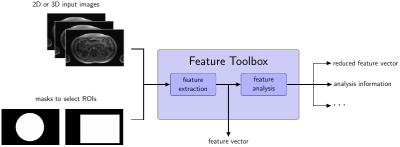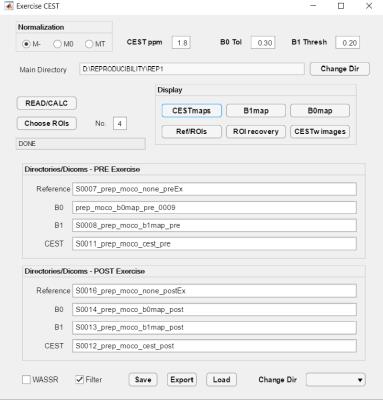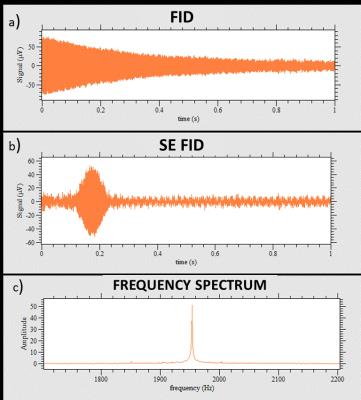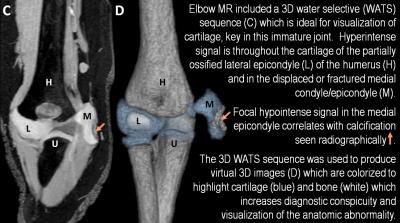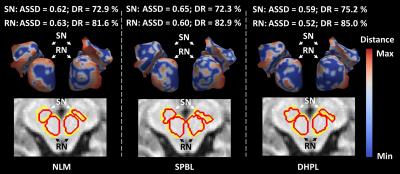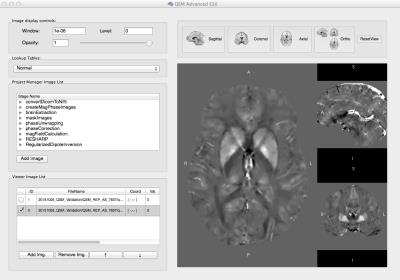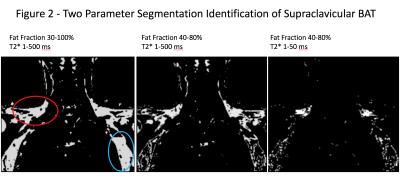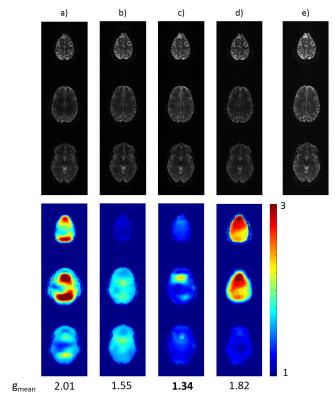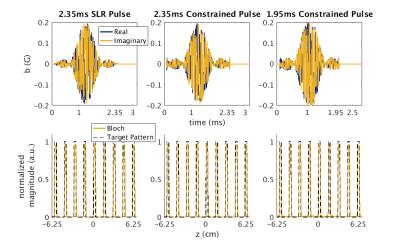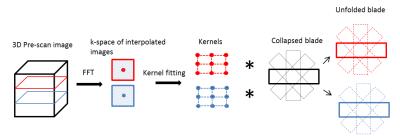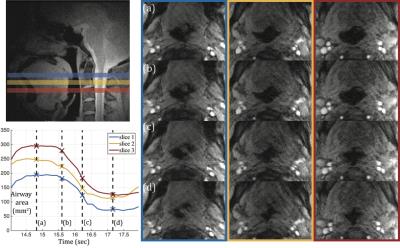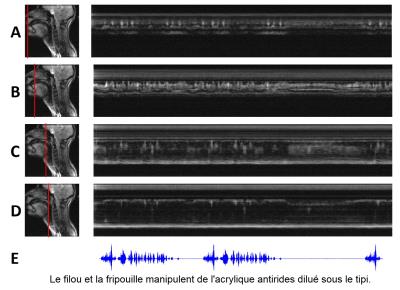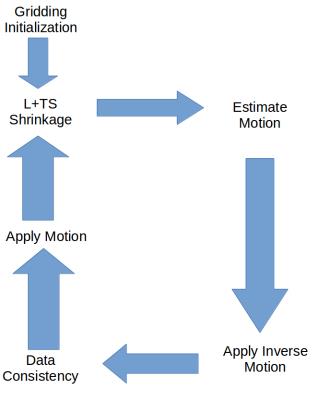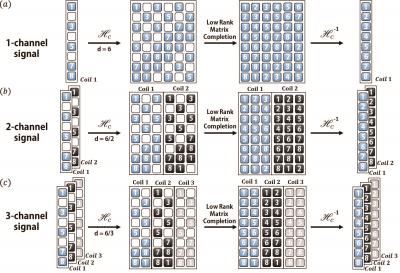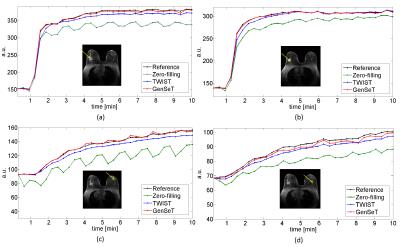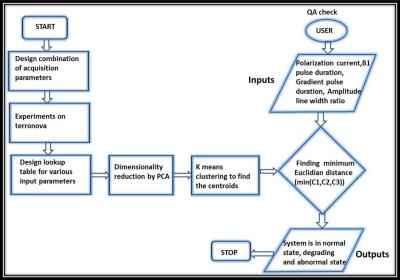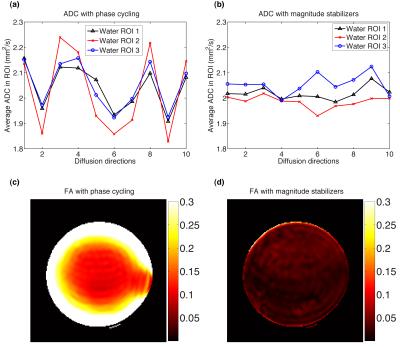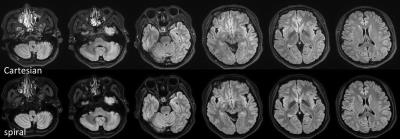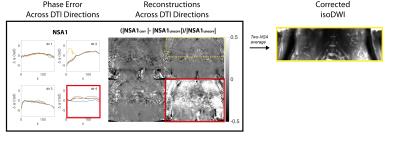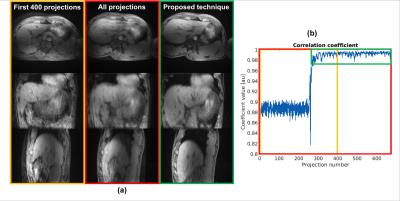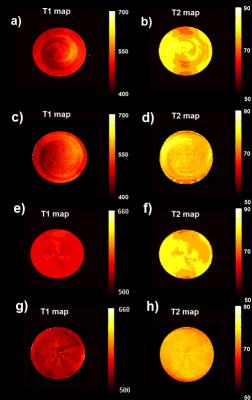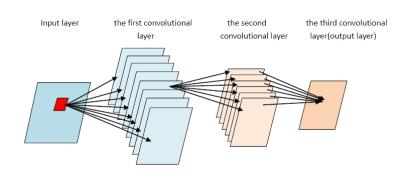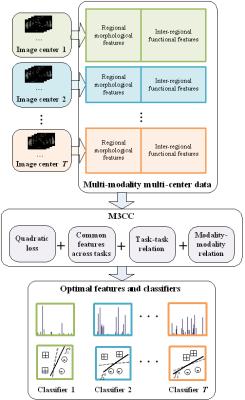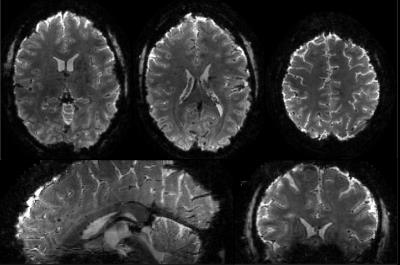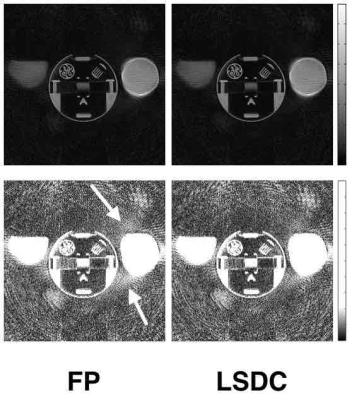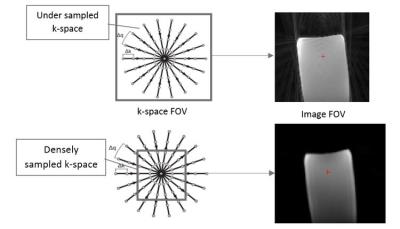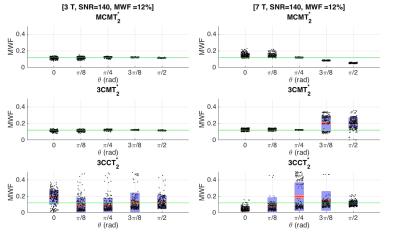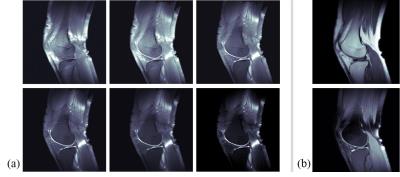Multimodal & Multiparametric
Electronic Poster
Acquisition, Reconstruction & Analysis
Tuesday, 25 April 2017
| Exhibition Hall |
08:15 - 09:15 |
| |
|
Computer # |
|
3879.
 |
73 |
Correlating ZTE MRI signal to bone density to derive a patient-specific attenuation correction map in brain PET/MR 
Maya Khalifé, Brice Fernandez, Olivier Jaubert, Michael Soussan, Irène Buvat, Vincent Brulon, Claude Comtat
Attenuation correction (AC) is needed for an accurate PET image quantification in brain PET/MR. Regular MRI cannot distinguish between different tissue types based on electron density, thus, Zero Echo Time (ZTE) has been used to segment bone, air and soft tissue. Furthermore, a correlation has been established between histogram normalized ZTE intensity and measured CT density in Hounsfield Unit (HU) in bone on a CT-MR database of 16 patients. The patient-specific AC map generated by combining ZTE-based segmentation and linear scaling of normalized ZTE signal into HU showed to be a good substitute of the measured CT-AC map in brain PET/MR.
|
|
3880.
 |
74 |
Fully-Integrated 3D High-Resolution Multi-Contrast Abdominal PET-MR with High Scan Efficiency 
Christoph Kolbitsch, Radhouene Neji, Matthias Fenchel, Andrew Mallia, Paul Marsden, Tobias Schaeffter
Abdominal PET-MR scans commonly combine free-breathing PET with breathhold or respiratory-triggered MR scans (T1/T2-weighted). This ensures high MR image quality but can lead to PET images impaired by motion blurring. Furthermore, PET can suffer from artefacts close to tissue-lung interfaces due to misalignment of breathhold MR-based attenuation correction (AC) information used for free-breathing PET. Here we present a free-breathing MR-technique which yields motion-compensated 3D T1-weighted and T2-weighted MR images. Respiratory-resolved AC maps and motion compensation improved uptake values (125±131%) and resolution (22±16%). Respiratory motion information is obtained with an accuracy of 1.3±0.1mm without an increase in scan time.
|
|
3886.
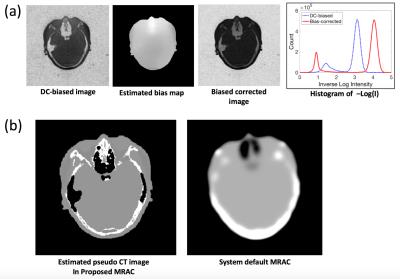 |
80 |
Rapid Dual Echo UTE MR-Based Attenuation Correction 
Hyungseok Jang, Alan McMillan
Recently, ultrashort TE imaging based MR-based attenuation correction (MRAC) has been proposed in literature to overcome the intrinsic difficulty in MRI to resolve bone contrast and hence enable more reliable estimation of attenuation map. However, the long acquisition time required for UTE imaging still remains challenging. In this study, we propose a novel, rapid dual echo method for UTE based MRAC, which allows segmentation of bone, air, fat, and water with high spatial resolution (1mm3) in a single scan with extremely short scan time (35sec).
|
|
3887.
 |
81 |
Atlas-based generation of synthesized transmission images for brain PETMR attenuation correction using MPRAGE 
Karl Spuhler, Nandita Joshi, Christine DeLorenzo, Ramin Parsey, Chuan Huang
Attenuation correction remains a challenge in simultaneous PETMR, as MR signal is not directly related to attenuation. This is particularly problematic in PETMR studies of the brain, where accurate radiotracer quantification is extremely important. Here, we present a method for generating individual-specific transmission data for attenuation correction from an input MPRAGE MR volume. The method uses an atlas of matched MPRAGE and transmission images in order to achieve this. Our method does not add to scan time, as do common MR-based methods, and directly yields attenuation data for PET energies, unlike CT-based methods.
|
|
3890.
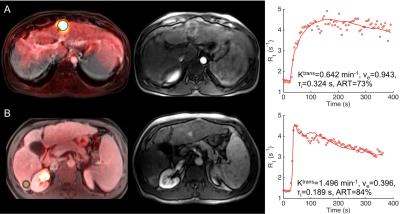 |
84 |
PET-MRI in hepatocellular carcinoma: Correlation of DCE-MRI perfusion quantification using shutter-speed model with FDG uptake 
Stefanie Hectors, Mathilde Wagner, Cecilia Besa, Wei Huang, Bachir Taouli
Shutter-speed modeling (SSM) of DCE-MRI data allows for estimation of the mean intracellular water molecular lifetime (τi), which has been suggested to be associated with tissue metabolic activity. In this study, we assessed the correlation between SSM DCE-MRI parameters and FDG-PET uptake in hepatocellular carcinoma (HCC) lesions. While Ktrans did show a significant negative correlation with the standardized uptake value (SUV) in the HCC lesions, τi was not significantly associated with FDG uptake. Our preliminary findings suggest that τi may not be associated with the up-stream tumor glucose metabolism as measured by FDG-PET.
|
|
3891.
 |
85 |
Detection of recurrent prostate cancer with 18F-Fluciclovine PET/MRI 
Kirsten Margrete Selnæs, Mattijs Elschot, Brage Krüger-Stokke, Håkon Johansen, Per Steen, Sverre Langørgen, Bjørg Aksnessæther, Gunnar Indrebø, Torill Sjøbakk, May-Britt Tessem, Siver Moestue, Heidi Knobel, Torgrim Tandstad, Helena Bertilsson, Arne Solberg, Tone Bathen
Simultaneous PET/MRI has the potential to improve the detection accuracy in recurrent prostate cancer, since it combines the excellent soft-tissue contrast of MRI with the high molecular sensitivity of PET in one imaging session. The aim of this observational study is to assess the detection rate of recurrent prostate cancer by simultaneous 18F-Fluciclovine PET/MRI. We demonstrate that18F-Fluciclovine PET/MRI can detect suspicious lymph node, prostatic and bone lesions in patients with a wide range of PSA levels and that the number of equivocal findings is reduced when MR images are evaluated in conjunction with PET uptake. .
|
|
3894.
 |
88 |
Water content, diffusion measures (DTI/DKI) and FET-PET in brain tumours: investigating similarities and differences 
Ana-Maria Oros-Peusquens*, Ricardo Loucao*, Hugo Ferreira, Karl-Josef Langen, Nadim Jon Shah
Water content, diffusion measures and FET-PET measured simultaneously on a hybrid 3T scanner in 40 brain tumour patients were investigated. Despite reasonable expectations of finding some microscopic-structure-driven correlations between these parameters, compared here for the first time, low correlations were found in healthy tissue. Interestingly, the correlation between water content and diffusion indices -while still rather low - increased in tumour tissue. Importantly, this implies that each parameter reflects different aspects and thus their combination should be more powerful for oncology than using single parameters
|
|
3898.
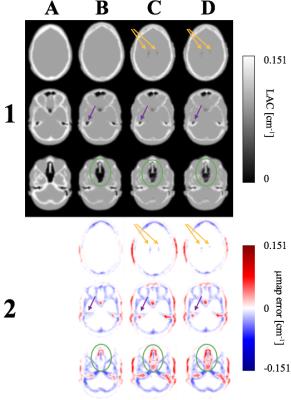 |
92 |
SPM-BASED SEGMENTATION OF AIR IN THE HUMAN HEAD FOR IMPROVED PET ATTENUATION CORRECTION IN SIMULTANEOUS PET/MR - permission withheld
Jakub Baran, Zhaolin Chen, Francesco Sforazzini, Sharna Jamadar, Nicholas Ferris, Nadim Shah, Marian Cholewa, Gary Egan
Dual-echo UTE MR sequences are widely used to estimate PET attenuation coefficients in simultaneous PET/MR imaging. However, due to susceptibility artefacts, air cavities in the head together with brain tissues and bones, can be misclassified, especially around air-tissue interface regions. In this work, we propose an SPM-based air and background segmentation method to improve the PET attenuation correction for simultaneous PET/MR imaging of the human brain. We compare air segmentation methods for more accurate air classification using an in-vivo MR-PET dataset and demonstrate improved PET image reconstruction accuracy.
|
|
3899.
 |
93 |
Impact of MR-based Motion Correction on clinical PET/MR data of patients with thoracic pathologies 
Marcel Gratz, Verena Ruhlmann, Lale Umutlu, Matthias Fenchel, Harald Quick
A new PET/MR method for MR-based motion correction of PET data was set up and evaluated in a clinical study to assess the potential gain of significance and visibility of lesions in the thorax for a free-breathing patient. The new method (MoCo) was applied to 20 patients and compared to reconstructions of a single respiratory state (gated) and the total non-corrected (static) dataset. Having a comparably high statistical confidence like the static PET imagery, the motion-corrected reconstruction shows superior image quality with sharper depiction of moving lesions and thus may facilitate the diagnosis of thoracic pathologies in routine PET/MR applications.
|
|
3900.
 |
94 |
MR-Based Respiratory and Cardiac Motion Corrected 18F-FDG-PET/MR in Cardiac Sarcoidosis 
Philip Robson, Nicolas Karakatsanis, Maria Giovanna Trivieri, Ronan Abgral, Marc Dweck, Jason Kovacic, Zahi Fayad
A major advantage of hybrid PET/MR systems is the radiation-free high spatial and temporal resolution of cardiac MR imaging that can be used to estimate respiratory and cardiac motion present during PET data acquisition. This information can be incorporated into algorithms to correct for the effects of motion in the PET data to reduce blurring and increase target-to-background ratios of PET hotspots. In this work, we demonstrate a method for respiratory and cardiac motion correction in patients with cardiac sarcoidosis.
|
|
3901.
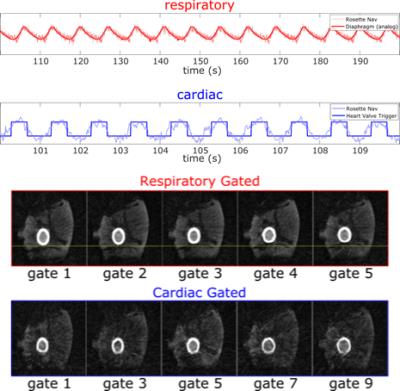 |
95 |
Automatic Extraction of Cardiac and Respiratory Motion via Self-Refocused Rosette Navigators and Independent Component Analysis 
David Rigie, Thomas Vahle, Tiejun Zhao, Klaus Schäfers, Björn Czekalla , Lynn Frohwein, Fernando Boada
Due to the recent availability of simultaneous PET-MR, there has been much interest in MR-based motion correction for PET imaging. A key component of any such scheme is a mechanism for tracking respiratory and cardiac motion phases throughout the entire exam. In this work, we present a robust, automated approach whereby respiratory and cardiac motion information is jointly encoded with rosette navigators and decoded via independent component analysis (ICA). This approach obviates the need for any external motion tracking devices (e.g. bellows or ECG) and requires just a contrast-neutral, self-refocused navigator echo (≈2ms) per repetition time and so may be easily incorporated into many clinical sequences.
|
|
3883.
 |
77 |
Validation of an Image Derived Input Function Method for PET/MR Brain Scans - permission withheld
Mohammad Mehdi Khalighi, Mathias Engström, Mark Lubberink, Greg Zaharchuk
Accurate measurement of the arterial input function (AIF) is essential in quantitative analysis of cerebral blood flow (CBF) using 15O-water PET imaging. The time-of-flight enabled SIGNA PET/MR scanner (GE Healthcare, Waukesha, WI, USA) provides high quality PET images, which can be used for non-invasive Image Derived Input Function (IDIF) estimation. AIF was measured using a proposed IDIF method on 4 patients and the results were compared with the gold standard, arterial blood sampling. The comparison shows excellent correspondence between IDIF and blood sampling, thus validating the IDIF method.
|
|
3884.
 |
78 |
Whole-body morphological and functional atlas using an integrated PET-MRI system and fat-water registration 
Simon Ekström, Therese Sjöholm, Filip Malmberg, Lars Lind, Håkan Ahlström, Joel Kullberg, Robin Strand
Today, when whole-body PET-MRI datasets are analyzed, the data is typically reduced to a few a priori specified measurements. New tools are developed in an attempt to utilize the full potential of large whole-body datasets. The purpose of this work was to build a preliminary whole-body atlas, containing both morphological (fat and water MR) and functional (FDG-PET) information on normality. An atlas was built out of 30 subjects using an integrated PET-MRI system together with an efficient registration method for fat-water MR images. The atlas was used in a proof-of-concept anomaly detection in FDG-PET using a pointwise t-test, which successfully detected anomalies in our test subject.
|
|
3885.
 |
79 |
Bayesian Experimental Design for Multi-Parametric T1/T2 Relaxometry and Diffusion - permission withheld
David Owen, Andrew Melbourne, Magdalena Sokolska, David Thomas, Jonathan Rohrer, Sebastien Ourselin
Multi-parametric imaging, such as joint relaxometry and diffusion, can allow for a time-efficient measurement of several parameters of interest. However, it is unclear how best to make use of valuable scanner time when using such novel imaging techniques. In this work, we explore how Bayesian experimental design can be used to derive a maximally time-efficient joint imaging experiment.
|
|
3895.
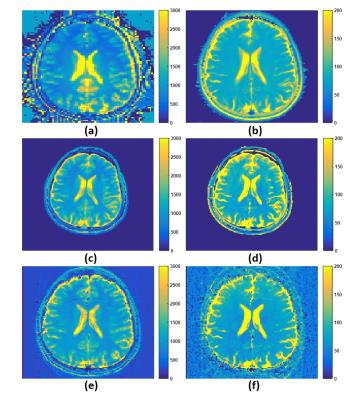 |
89 |
In Vivo T1 and T2 Mapping using Single-Shot EPI Fingerprinting 
Cory Wyatt, John Grinstead, Alexander Guimaraes
MR fingerprinting (MRF) studies have been performed using heavily undersampled spiral acquisitions, which constantly rotate and use uncorrelated aliasing to fit quantitative T1 and T2 maps. On top of the usual spiral sensitivity to off-resonance, the undersampling used in MRF requires a slowly varying signal evolution to “see through” the aliasing artifacts. Echo-planar imaging (EPI) would avoid these aliasing issues while still having a short measurement time due to a single-shot acquisition and parallel imaging acceleration. In this study, a single-shot EPI sequence is combined with fingerprinting techniques to obtain T1 and T2 maps similar to those from spiral fingerprinting.
|
|
3896.
 |
90 |
Fast Magnetic Resonance Fingerprinting of Mouse Brain Using a Spiral Trajectory 
Yuning Gu, Charlie Wang, Christian Anderson, Yuchi Liu, Dan Ma, Yun Jiang, Mark Griswold, Chris Flask, Xin Yu
In this study we developed spiral-based MRF sequences for fast T1 and T2 mapping of mouse brain at 7T. A variable density spiral trajectory that fully sampled the inner 10×10 k-space with 4 interleaves enabled up to 6-fold acceleration for both MRF-bSSFP and MRF-FISP sequences, corresponding to a 3-min scan to acquire 1024 time frames for simultaneous T1 and T2 mapping.
|
|
3897.
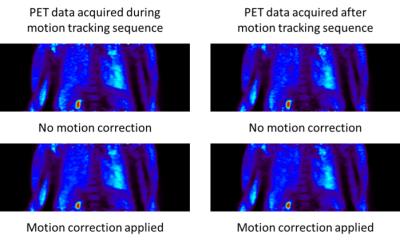 |
91 |
PET-MR Motion Correction of Entire Listmode Data Sets Using Pilot Tone Navigation 
Thomas Vahle, David Rigie, Ryan Brown, Tiejun Zhao, Li Feng, Matthias Fenchel, Peter Speier, Fernando Boada
The introduction of simultaneous PET-MR provides new opportunities for motion tracking and correction during PET imaging. The ideal clinical workflow for a PET-MR exam would allow for PET data to be continuously acquired alongside any desired MR sequences and to reconstruct a motion-corrected PET image utilizing the entire dataset. In this work we combine a surface coil driven by an external signal generator with an MR motion model to navigate PET data during an entire PET-MR exam. We demonstrate the approach on one human subject that underwent a PET-MR exam.
|
|
3892.
 |
86 |
Simultaneous acquisition of T1rho and T2 map of liver with black blood effect in a single breathhold 
Weitian Chen, Vincent Wong, Queenie Chan, Yixiang Wang, Winnie Chu
T1rho is promising for early detection of liver fibrosis. However, the richness of blood vessels in the liver coupled with respiratory motion makes T1rho measurement prone to errors. In this work, we propose a pulse sequence to simultaneously obtain a T1rho and a T2 map of liver in a single breathhold with black blood effect.
|
|
3893.
 |
87 |
Using 31P-MRI of hydroxyapatite for bone attenuation correction in PET-MRI: proof of concept in the rodent brain 
Vincent Lebon, Sébastien Jan, Yoann Fontyn, Brice Tiret, Géraldine Pottier, Emilie Jaumain, Julien Valette
Current techniques for skull attenuation correction in PET-MRI provide indirect estimates of cortical bone density, leading to inaccurate estimates of brain activity. Here we propose an alternate method based on the detection of hydroxyapatite crystals by 31P-MRI, providing individual and quantitative assessment of bone density. 31P-MRI was performed in rodent to estimate the µ-map of the skull. FDG-PET data were acquired in the same animal and reconstructed with 31P-based attenuation correction, demonstrating proper distribution of 18F activity throughout the brain.
|
|
3888.
 |
82 |
Intensity inhomogeneity correction of whole body fat-water images using fat and water fraction information on a 3T PET/MR scanner 
Therese Sjöholm, Simon Ekström, Filip Malmberg, Robin Strand, Magnus Johansson, Lars Lind, Mathias Engström, Håkan Ahlström, Joel Kullberg
We describe and evaluate a method for intensity non-uniformity correction of whole-body fat-water MR data acquired with both surface and body coils on a 3T PET/MRI system. The proposed method consists of two steps. Abrupt station intensity changes are first supressed, followed by correction of smooth intensity changes using fat and water fraction information. Visual and quantitative evaluations of 42 corrected fat-water datasets show that the method gives improved adipose and lean tissue uniformity for both surface and body coil acquisitions. This renders the data suitable for continued analysis in a whole-body imaging framework.
|
|
3889.
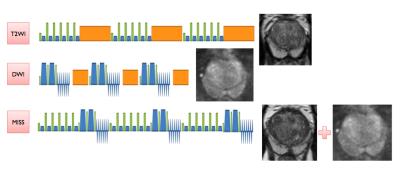 |
83 |
Multiple Instantaneous Switchable Scans interleaving T2W and DWI for Prostate Biparametric MRI 
Wei WANG, Xiubo QIN, Juan WEI, Xiaoying WANG
Multiple Instantaneous Switchable Scans (MISS) is a type of interleaved scan method. In our study of prostate MRI, we combined the 3D-T2W and DWI by MISS into one scan, both of which are essential sequences for PIRADS v2. The combined sequences improved the scan efficiency (6min to 4min30s). The image quality and lesion display of MISS is similar to conventional T2W and DWI. The 3D-T2W in MISS showed better performance of seminal vesicles and lesion contrast and allowed for interactive multiplanar reformation.
|
|
3881.
 |
75 |
Penta-contrast imaging: a Novel Pulse Sequence for Simultaneous Acquisition of Proton Density, T1, T2, T2* and FLAIR images 
Jinhee Jeong, Yoonho Nam, Jongho Lee
A penta-contrast imaging sequence that generates proton density (PD), T1, T2, T2* and FLAIR images in a single scan is developed. Compared to conventional imaging sequences, the scan time is reduced by 50 %. Additionally, the new method generates T1 and T2 maps.
|
|
3882.
 |
76 |
Magnetic Resonance Fingerprinting for T1 and T2* quantification with Cartesian readout 
Benedikt Rieger, Fabian Zimmer, Jascha Zapp, Sebastian Weingärtner, Lothar R. Schad
Magnetic resonance fingerprinting (MRF) has shown exceptional promise for simultaneous quantification of T1 and T2, based on numerous spiral readouts. We propose an implementation of the MRF paradigm for quantitative imaging using spoiled echo-planar imaging (EPI) with Cartesian readout for simultaneous assessment of T1 and T2* within 10s. Joint T1 and T2* parameter-maps acquired in phantoms with the proposed MRF method are in good agreement with reference measurements and demonstrate high quality in-vivo. This approach offers a rapid supplement to the non-Cartesian MRF portfolio, with potentially increased usability and robustness.
|
|









